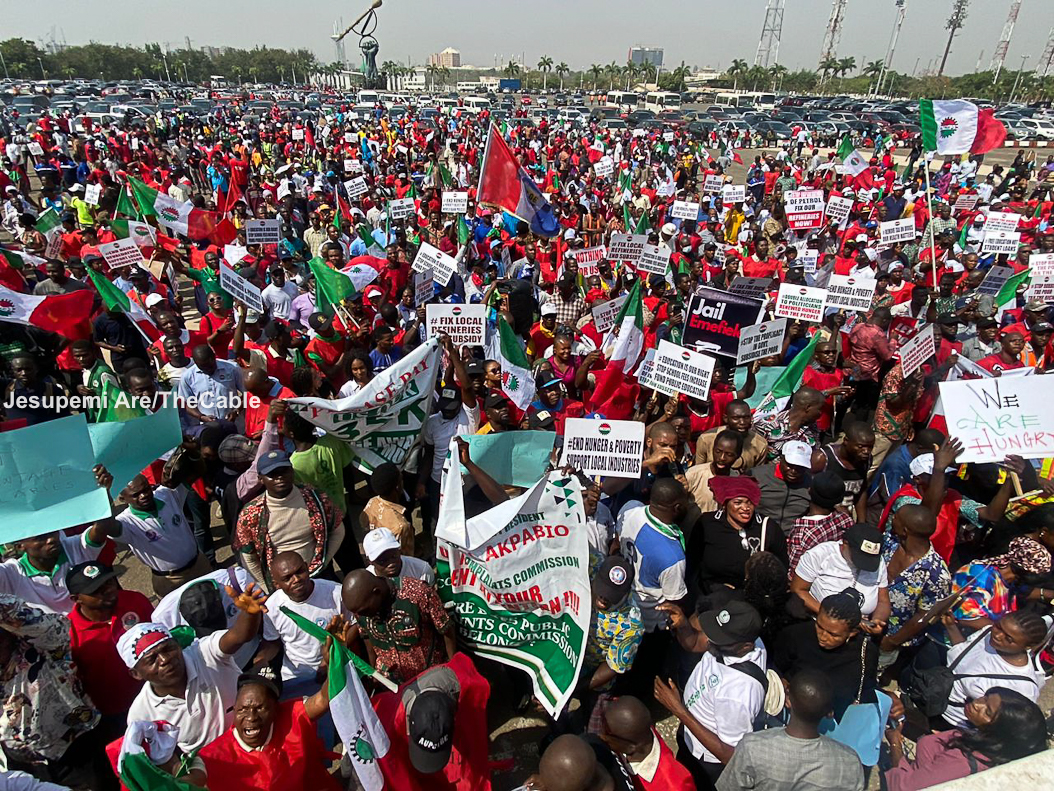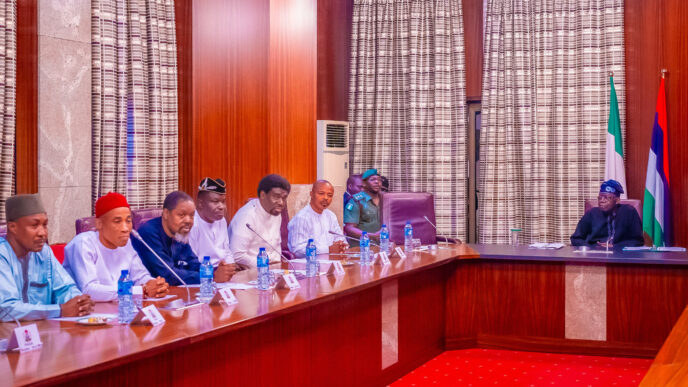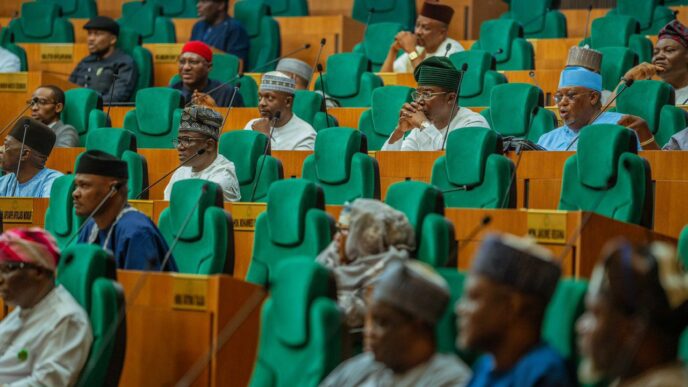File photo: NLC protest in February 2024
On June 3, there was a nationwide blackout after the national electricity grid was shut down. With over 200 grid collapses since 2010, Nigerians are not unaccustomed to periodic power cuts. But that of June 3 was unique because it was not due to any technical fault.
The Transmission Company of Nigeria (TCN) had said the labour unions, led by the Nigeria Labour Congress (NLC) and the Trade Union Congress (TUC), shut down the national grid, subjecting people and their businesses to a blackout. Airport operations were grounded too.
In April, organised labour proposed an increase in the new minimum wage of workers to N615,000 to enable them to cope with the current economic realities and high cost of living.
Their demand is premised on the Minimum Wage Act which stipulates a wage review every five years. The Minimum Wage Act of 2019, which introduced the N30,000 wage, expired in April.
Advertisement
The tripartite committee on new national minimum wage recommended N62,000 to the federal government on June 10, while the national assembly said it is willing to approve an increase to N70,000 — but organised labour has insisted on N250,000, shifting from an initial position of N615,000.
President Bola Tinubu is still consulting with states and the private sector before submitting a bill to the national assembly on the new national minimum wage.
Since the agitations began, there have been various suggestions regarding what a fair wage would be. Some have said N100,000, and others have recommended lower figures. There have also been concerns about the ability of the government to accommodate a wage increase.
Advertisement
These arguments are valid given the overall economic milieu. But what does available data tell us about this, especially vis-à-vis the capacity of states to pay increased wages?
14 STATES HAVE BEEN UNABLE TO IMPLEMENT THE 2019 WAGE
Since the current N30,000 minimum wage came into force in 2019, not all states were able to pay within the five-year period. Some governors only started paying recently. For instance, Zamfara announced in May 2024 that it would implement the N30,000 wage – after labour unions issued a two-week ultimatum to defaulting states.
Available data show that only about 22 states have implemented the current wage while 14 subnational governments are yet to begin implementation. According to data by SBM Intelligence, the 14 states include Abia, Bayelsa, Delta, Enugu, Nasarawa, Adamawa, Gombe, Niger, Borno, Sokoto, Anambra, Imo, Benue, and Taraba.
Advertisement
States currently paying are Akwa Ibom, Ebonyi, Edo Jigawa, Plateau, Yobe, Lagos Ogun, Oyo, Ondo, Osun, Ekiti, Rivers, Cross River, Kano, Kaduna, Katsina, Kwara, Zamfara, Kogi, Bauchi, and Kebbi.
INCREASED RECURRENT EXPENDITURE
Amid the clamour for a new minimum wage, there is no mutually acceptable percentage of increase. Considering all factors that have contributed to an inflation rate of 34 percent, including the tripling of petrol price, some have recommended a 233 percent hike which amounts to N100,000.
The federal government has proposed N62,000, representing a 106.6 percent increase while the national assembly is inclined to greenlight N70,000, which is a 133.3 percent hike.
Advertisement
Irrespective of what percentage is adopted, any wage review would raise states’ total expenditure with a chunk of it coming from increased recurrent expenditure, such as personnel costs, allowances, benefits, and overheads.
WHAT A 50 or 100% INCREASE IN 2022 WOULD HAVE MEANT
Advertisement
Based on data obtained from the Nigeria Governors Forum (NGF) website, in 2022, Abia’s total revenue — made up of internally generated revenue, FAAC allocations, and aids and grants — was N147,637,730,867.
The state’s recurrent expenditure stood at N111,983,979,958 while net revenue was N35,653,750,909. If the state increased wages by 50 percent in 2022, its recurrent expenditure would have jumped to N167,975,969,937, surpassing its total revenue and leading to a deficit — thereby making it difficult to pay.
Advertisement
Applying the same calculation to other states, TheCable found that 13 states (including Abia) would have run a deficit in 2022, meaning they would not have been able to meet their obligation in the payment of salaries and allowances. These states are Benue, Ekiti, Enugu, Katsina, Kogi, Kwara, Nasarawa, Osun, Plateau, Taraba, Yobe and Zamfara.
But if wages were increased by 100 percent, only Anambra, Bayelsa, Borno, Ebonyi, Gombe, Imo, Jigawa, Kaduna, Lagos, and Rivers would have heen able to meet their obligations on recurrent expenditure — with little revenue left for projects.
Advertisement
WHAT A PRESENT-DAY 50% INCREASE AMOUNTS TO
According to the NGF data, the total budgeted revenue of the 36 states in 2024 is N15,668,697,471,227; recurrent expenditure is N6,212,475,163,133 while net revenue stands at N9,456,222,308,093 — without increases.
If wages, however, increase by 50 percent, recurrent expenditure swells to N9,318,712,744,700 while net revenue would be N6,349,984,726,526.
This means all states will be able to meet their obligation in the payment of salaries and allowances, but some of them (e.g. Nasarawa, Adamawa, Kogi, Edo, Osun, Ekiti) will have little revenue remaining to execute capital projects.
Given that the budgeted revenue and recurrent expenditures for 2024 may have been prepared based on the budget performance of previous years (2021/2022), it is possible that revenue increases accruing to states from subsidy removal may not be captured by the NGF.
THE NARROW WAY OUT
From whatever prism the minimum wage debate is viewed and whatever increase the organised labour accepts, the outcome remains the same: governments’ revenues will be impacted. To survive, governments will need to generate revenue through various means including raising taxes, increasing borrowing, and boosting IGR.
The federal government already has a N121 trillion debt to deal with amid high interest rates. States are also facing huge debts. While Lagos has the highest debt stock, it also has the highest IGR, gulping 34 percent of the total IGR in 2022. In essence, without FAAC allocations, many states will be bankrupt as they are not creative enough in terms of boosting their IGRs — which explains why only two states could attract foreign investments in the first quarter (Q1) of 2024.
On taxes, Nigerians are already overburdened. There are around 200 unofficial taxes and over 60 official ones, Taiwo Oyedele, chairman of the presidential committee on fiscal policy and tax reforms, disclosed recently. Raising taxes at this time would be frowned on by the masses.
HOW DOES IT AFFECT THE PRIVATE SECTOR?
An aspect that is often overlooked is the impact of a new minimum wage on the private sector. Infrastructural deficits, insecurity, high energy costs, foreign exchange (FX) and many other challenges mean that Nigeria’s business environment is not particularly the best.
Aliko Dangote, president of the Dangote Group, recently warned that high interest rates would stifle job creation. According to Shakirudeen Taiwo, an economist with the Nigerian Economic Summit Group (NESG), increasing the minimum wage would have a similar effect.
Taiwo said the proposed N62,000, which targets mostly the lower-cadre employees (security men, cleaners, drivers etc) in the private sector, is above the statistical limits of between N35,000 to N50,000 for such class of workers.
“That is where the private sector will be affected seriously, because, first is that it will affect them in renegotiating existing lower-cadre service that’s being provided by their HR organisations and majority of the companies that would be affected are those in the service sector,” he said.
“Companies that work in the banking sector, the manufacturing sector, because these categories of employers are the drivers, the cleaners, for the banking sector — the tellers. And in terms of numbers, they’re actually more than the lower-level management in the payroll of these private sector firms.
“So, first, it’s going to lead to [increase] in cost-to-company per employee — the lower-cadre employee now — for the private sector.”
The economist said a higher wage increases the overall cost of operation of businesses as it adds to the personnel side of the firms. Hence, the private sector might be forced to look “at integrating these lower-cadre employees into their full work screen, which may then have an additional cost: pension arrangement, tax among others, and these overall affect their bottom line”.
Taiwo said organisations may be forced to restructure their workforce. For instance, two similar functions may be merged and “one employer actually having to do more than expected and they retrench a lot of staff in the company”.
He said the situation may lead to an increase in unemployment and a “delay in growth for medium-size companies”.
Add a comment










